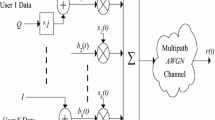Abstract
CDMA-only microcell/macrocell cellular systems have traditionally suffered from the near-far problem in the microcells located near the macrocell boundary. Strong macrocell interference in these microcells disables conventional single-user detectors. The solutions currently adopted in the literature include bandwidth-consuming frequency separation between macrocell and microcell tiers and complex hybrid architectures. In this work we present the techniques for multiuser receiver design that address this problem. The preprocessing stage, called the projection stage, which projects the received signal onto the space orthogonal to the subspace spanned by macrocell users' signature sequences, is introduced. It is followed by the stage employing conventional multiuser detection (MUD) techniques. This class of detectors, called multiuser projection detectors (MPD), provides efficient protection against macrocell interference in all microcells, regardless of their location within the macrocell. The protection is optimal if the amplitudes of macrocell interferers are not known by the microcell BS. We analyze four MPDs using different MUD techniques in the detection stage, and perform performance comparison.
Similar content being viewed by others
REFERENCES
S.A. El-Dolil et al., Teletraffic performance of highway microcells with overlay macrocell, IEEE Journal on Selected Areas in Communications, Vol.7, No.1, pp.71–78, 1989.
T.-S.P. Yum and W.-S. Wong, Hot-spot traffic relief in cellular systems, IEEE Journal on Selected Areas in Communications, Vol.11, No.6, pp.934–940, 1993.
A. Catovic and B. Jabbari, Effect of non-uniform traffic load on Erlang capacity of CDMA, Proceedings of the 49th IEEE Vehicular Technology Conference, Houston, Texas, May 1999 Vol.1, pp.816–820.
L.-C. Wang et al., Architecture design, frequency planning and performance analysis for a microcell/macrocell overlaying system, IEEE Transactions on Vehicular Technology, Vol.46, No.4, pp.836–848, 1997.
C.-L. I et al., A microcell/macrocell cellular architecture for lowand high-mobility wireless users, IEEE Journal on Selected Areas in Communications, Vol.11, No.6, pp.885–891, 1993.
E. Dahlman et al., UMTS/IMT-2000 based on wideband CDMA, IEEE Communications Magazine, Vol.36, No.9, pp.70–80, 1998.
A. Duel-Hallen et al., Multiuser detection for CDMA systems, IEEE Personal Communications, Vol.2, No.2, pp.46–57, 1995.
S. VerdÚ, Multiuser Detection, Cambridge University Press, 1998.
H.V. Poor and S. VerdÚ, Probability of error in MMSE multiuser detection, IEEE Transactions on Information Theory, Vol.43, No.3, pp.858–871, 1997.
A.J. Viterbi, CDMA, Principles of Spread Spectrum Communication, Addison-Wesley, Reading, MA, 1995.
K.S. Gilhousen et al., On the capacity of a cellular CDMA system, IEEE Transactions on Vehicular Technology, Vol.40, No.2, pp.303–312, 1991.
A.J. Viterbi et al., Other-cell interference in cellular power-controlled CDMA, IEEE Transactions on Communications, Vol.42, No.2, pp.1501–1504, 1994.
R. Lupas and S. VerdÚ, Linear multiuser detectors for synchronous code-division multiple-access channels, IEEE Transactions on Information Theory, Vol.35, No.1, pp.123–136, 1989.
M.K. Varanasi and B. Aazhang, Near-optimum detection in synchronous CDMA systems, IEEE Transactions on Communications, Vol.39, No.5, pp.725–736, 1991.
M.K. Varanasi and B. Aazhang, Multistage detection in asynchronous CDMA communications, IEEE Transactions on Communications, Vol.38, No.4, pp.509–519, 1990.
A. Duell-Hallen, Decorrelating decision-feedback multiuser detector for synchronous CDMA channel, IEEE Transactions on Communications, Vol.41, No.2, pp.285–290, 1993.
R. Gold, Optimal binary sequences for spread spectrum multiplexing, IEEE Transactions on Information Theory, Vol.IT-13, pp.619–621, 1967.
Author information
Authors and Affiliations
Rights and permissions
About this article
Cite this article
Catovic, A., Tekinay, S. Multiuser Detection Techniques for Hierarchical Cell Structures in CDMA Cellular Systems. International Journal of Wireless Information Networks 9, 25–38 (2002). https://doi.org/10.1023/A:1014828301301
Issue Date:
DOI: https://doi.org/10.1023/A:1014828301301




